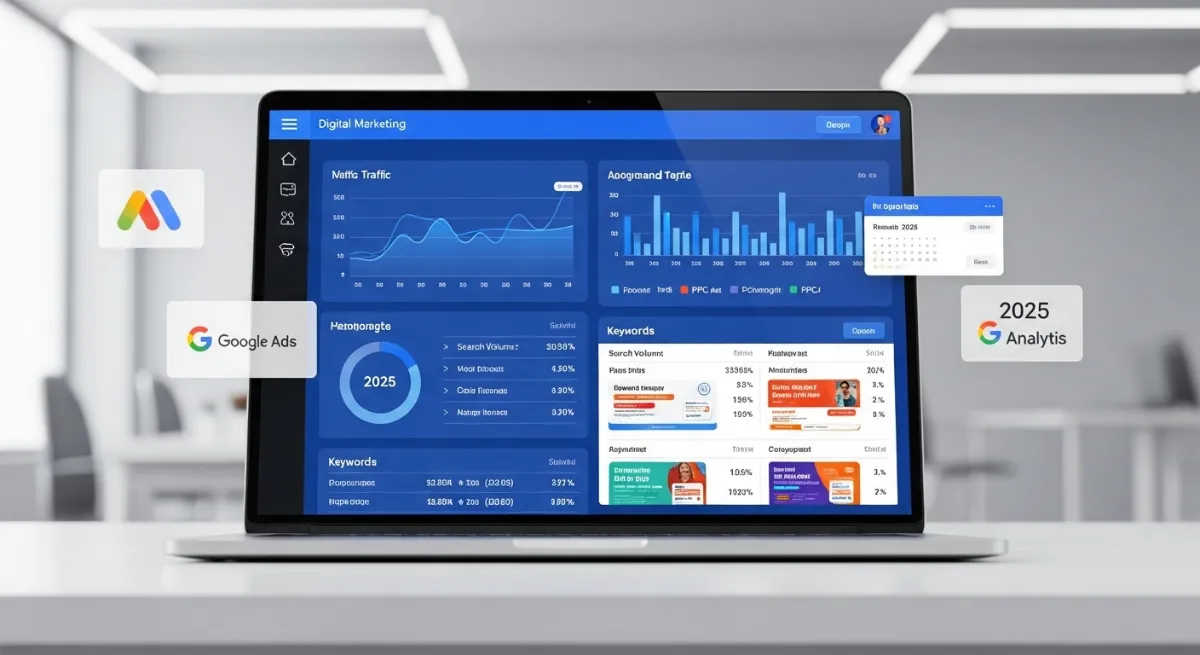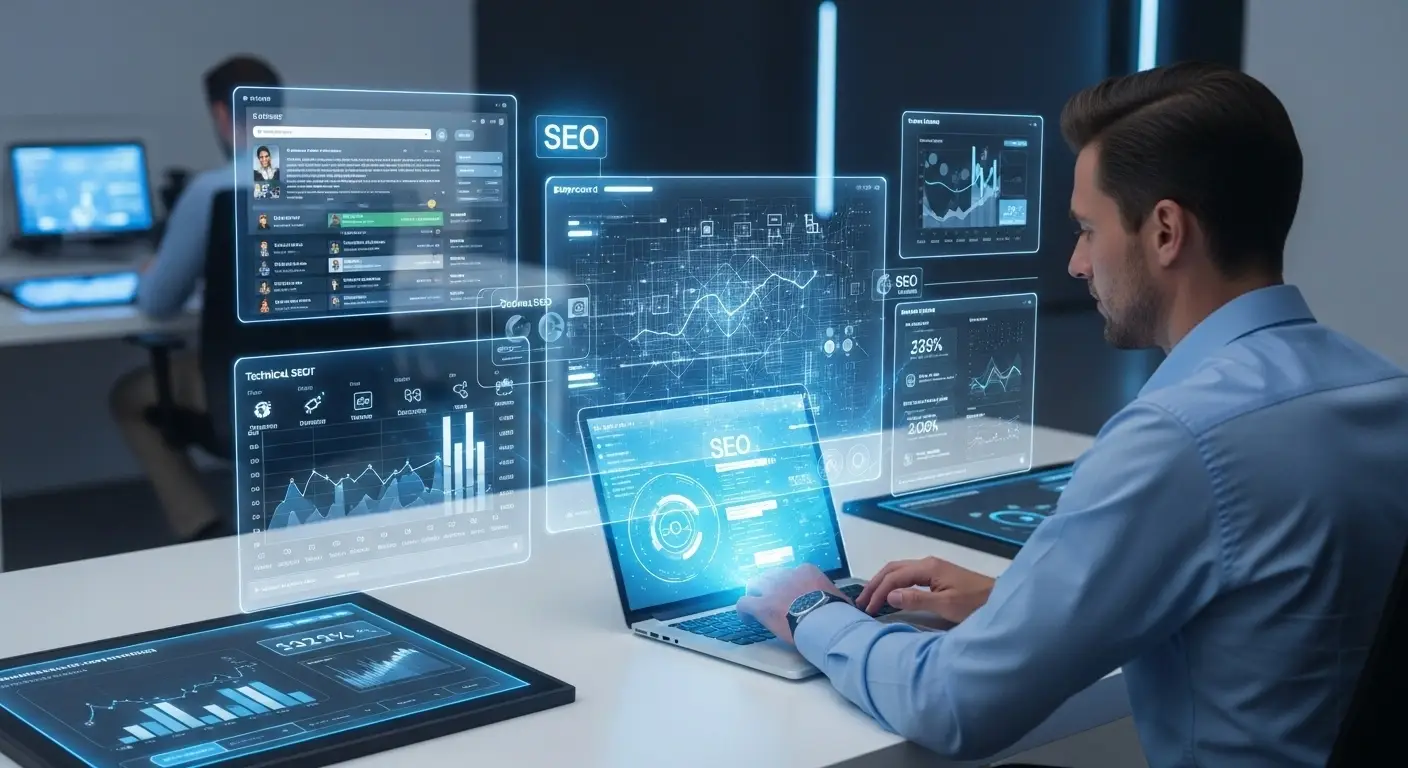What Is Search Engine Marketing (SEM)?
In the fast-paced digital economy, every brand is fighting for attention. Getting noticed organically can take months, sometimes years — and that’s why Search Engine Marketing (SEM) has become the go-to strategy for businesses seeking instant online visibility.
Search Engine Marketing is the process of promoting your website through paid advertising on search engines like Google or Bing. When users search for keywords related to your product or service, your ad appears right at the top of the results, driving immediate clicks and conversions.
You can think of SEM as a shortcut to visibility — instead of waiting for SEO to mature, SEM helps you appear in front of ready-to-buy audiences in a matter of minutes.
How SEM Works
At its core, SEM is powered by Pay-Per-Click (PPC) advertising. Businesses bid on keywords, and when users search for those terms, search engines run an ad auction to determine which ads show up and in what order.
The most common platform for SEM is Google Ads, but alternatives like Microsoft Advertising (Bing Ads) also drive strong results for specific demographics.
| Element | Description |
|---|---|
| Keyword Bidding | Advertisers choose and bid on search terms relevant to their offering. |
| Ad Auction | The search engine decides which ads appear based on the bid and ad quality. |
| Quality Score | A Google metric evaluating ad relevance, landing-page experience, and click-through rate. |
| Ad Rank | Your ad’s final position in the results — calculated from bid × quality score. |
A high-performing SEM campaign balances budget, quality, and audience targeting to ensure you reach the right people at the right time.
Why Search Engine Marketing Matters

- Instant Visibility: Get your brand in front of users searching for what you sell — today.
- Qualified Traffic: Reach customers with strong purchase intent.
- Flexible Budgeting: You can start small and scale as results grow.
- Measurable Results: Every impression, click, and conversion is tracked in real time.
- Brand Trust: Constant top-of-page exposure builds authority and recognition.
A well-structured SEM campaign allows startups, e-commerce brands, and local businesses to compete with big players — even with modest budgets.
SEO vs. SEM — What’s the Difference?
Both SEO and SEM aim to boost search visibility, but they differ in speed, cost, and intent. SEO builds credibility and long-term growth, while SEM offers instant exposure through paid placements.
| Aspect | SEO (Search Engine Optimization) | SEM (Search Engine Marketing) |
|---|---|---|
| Goal | Rank organically | Appear via paid ads |
| Cost | No direct payment per click | Pay-per-click (PPC model) |
| Timeframe | Slow & sustainable | Immediate but temporary |
| Visibility | Grows gradually | Instant on launch |
| Ideal For | Long-term authority | Quick traffic & testing |
In most cases, the smartest strategy combines both — use SEM for fast results while SEO builds your foundation for consistent organic traffic.
Pro Tip: Run A/B tests on ad copy and landing pages using tools like HubSpot A/B Testing Guide . Even a 2% increase in click-through rate can lead to hundreds of extra conversions over time.
When to Choose SEM for Your Business

- New Launches: Promote new products or services instantly.
- Seasonal Campaigns: Perfect for limited-time discounts or holiday offers.
- Competitive Industries: Outrank established competitors with paid placements.
- Local Businesses: Target nearby customers with location-based ads.
Partnering with a professional SEM agency ensures you avoid costly mistakes like keyword overlap, poor targeting, or low ad quality scores.
An experienced team, like those offering SEM services at Fast Digital 360, can craft campaigns that align budget, keywords, and user intent for maximum ROI.
The Power of Data-Driven SEM
Modern SEM isn’t guesswork — it’s analytics-driven precision. By tracking metrics such as Cost Per Click (CPC), Conversion Rate, and Return on Ad Spend (ROAS), you can refine every campaign for better performance.
Use platforms like Google Analytics or HubSpot Marketing Analytics to measure how paid traffic interacts with your website and where to optimize your ad spend.
| Metric | Purpose |
|---|---|
| CPC (Cost Per Click) | Tracks the cost per ad click. |
| CTR (Click-Through Rate) | Measures ad engagement. |
| ROAS (Return on Ad Spend) | Shows revenue generated per dollar spent. |
| Conversion Rate | Indicates how well ads drive actual actions (sales, sign-ups). |
Pro Tip: Always align your landing-page design with ad intent. If your ad says “Buy Digital Marketing Courses,” send users directly to that offer — not your homepage.
The Long-Term Benefit of SEM
While SEM offers short-term wins, its insights provide long-term value. The data from paid campaigns reveals which keywords convert best — insights that strengthen your SEO and content strategy.
In essence, SEM is not just advertising; it’s a feedback loop for improving your entire marketing ecosystem.
Building a Winning SEM Strategy
Creating a powerful Search Engine Marketing (SEM) campaign goes far beyond placing a few ads. To get consistent, profitable results, businesses need a clear structure, a smart bidding approach, and data-driven optimization. Whether you manage campaigns in-house or work with a professional SEM agency, understanding these key components ensures you invest wisely and outperform your competitors.
1. Setting Clear Campaign Goals

Every successful SEM campaign starts with a goal. Are you trying to increase website traffic, generate leads, sell products, or build brand awareness?
Your goals determine your ad type, keyword strategy, and budget. For example:
- A local business might focus on Google Search Ads targeting “near me” queries.
- An e-commerce store may run Shopping Ads to highlight specific products.
- A new startup may use Display Ads for brand visibility.
By aligning your objectives with your ad formats, you ensure every dollar contributes to measurable results.
Google Ads Campaign Types offers an in-depth look at each ad format and when to use them.
Pro Tip: Use the SMART goal framework — Specific, Measurable, Achievable, Relevant, and Time-bound — before launching your SEM campaign. This keeps your ads focused and prevents wasted spend.
2. Keyword Research and Selection
The backbone of search engine marketing is keyword research. Choosing the right keywords ensures your ads appear to users with the highest intent to buy.
You can use tools like SEMrush Keyword Magic Tool or Google Keyword Planner to find keywords that have high search volume and reasonable cost-per-click (CPC).
Keyword Types in SEM:
| Keyword Type | Purpose | Example |
|---|---|---|
| Broad Match | Reach widest audience | marketing services |
| Phrase Match | Match similar search phrases | “digital marketing agency” |
| Exact Match | Show ads only for specific phrases | [sem agency in Pakistan] |
| Negative Keywords | Exclude irrelevant searches | “free,” “jobs,” “cheap” |
For better ROI, focus on long-tail keywords — phrases with specific intent such as “hire SEM agency for eCommerce” or “best SEM services for startups.” These often have lower competition and higher conversion rates.
3. Crafting Compelling Ad Copy
Your ad copy is the first impression users have of your brand. A strong SEM ad combines relevance, emotion, and a clear call-to-action (CTA).
Effective ads include:
- The primary keyword in the headline.
- A unique selling point (USP) that differentiates you.
- A compelling CTA, like “Get a Free Quote,” “Buy Now,” or “Contact Today.”
For example:
“Boost Traffic Fast with Expert SEM Services — Partner with Pakistan’s Leading SEM Agency for Measurable Results!”
You can also use Google Responsive Search Ads Guide to test multiple ad headlines and automatically show the best-performing versions.
Pro Tip:
Use emotional triggers like
urgency (limited-time offer
),
social proof (trusted by 100+ clients
), or
exclusivity (only for members
)
to increase click-through rates (CTR).
4. Building High-Converting Landing Pages

Your ad may win the click — but your landing page wins the conversion. A well-optimized page should match the ad message, load fast, and include a clear call-to-action.
Here’s what to focus on:
- Message Match: If your ad says “Buy SEO Tools,” don’t send visitors to your homepage — take them directly to that product page.
- Speed Optimization: Use Google PageSpeed Insights to test and improve page performance.
- Mobile Responsiveness: Ensure your landing page adapts to all screen sizes.
- Trust Elements: Add testimonials, security badges, and clear contact info.
These improvements don’t just increase conversions — they also improve your Quality Score, lowering the cost of future campaigns.
5. Setting Budgets and Bids
Managing budgets efficiently ensures your SEM campaigns remain profitable.
Start with a daily budget that aligns with your business goals and CPC estimates. Adjust bids based on ad performance — invest more in high-performing keywords and pause underperforming ones.
Use External Link: Google Ads Bid Strategies to understand automated bidding options such as:
- Maximize Conversions
- Target CPA (Cost per Acquisition)
- Target ROAS (Return on Ad Spend)
These help Google’s AI automatically adjust your bids to get the best return on your investment.
6. Measuring Success and Optimization
After launching your campaign, ongoing optimization becomes essential. Review analytics weekly to identify:
- Which keywords convert best.
- What ad copies have the highest CTR.
- Which times or locations perform strongest.
You can use HubSpot Marketing Analytics or Google Data Studio to visualize SEM performance across multiple campaigns.
Refine campaigns by adjusting bids, improving copy, and testing new ad variations. Even a small 1% CTR increase can make a massive impact on your overall ROI.
7. Why Partnering with an SEM Agency Matters

While small campaigns can be managed in-house, scaling your results requires the expertise of a professional SEM agency.
A trusted SEM agency brings:
- Deep keyword research expertise.
- Data-backed bidding strategies.
- Optimized landing pages for conversion.
- Continuous monitoring and adjustments.
At Fast Digital 360, our SEM services are designed to help businesses dominate search results, reduce ad spend waste, and generate measurable growth. Whether you’re new to paid advertising or looking to refine existing campaigns, our team ensures your budget delivers maximum impact.
The Future of Search Engine Marketing
The world of Search Engine Marketing (SEM) is evolving faster than ever. What worked two years ago — simple keyword targeting and manual bidding — no longer guarantees results. Today, success in SEM demands automation, audience intelligence, and continuous data optimization.
Whether you manage campaigns independently or rely on a professional SEM agency, understanding the future of SEM is key to staying ahead of your competitors.
1. The Rise of AI and Automation in SEM
Artificial intelligence (AI) has completely transformed how advertisers manage their search campaigns. Google’s Smart Bidding Technology uses real-time data to optimize bids automatically for conversions, helping marketers save time and money.
AI systems now analyze millions of signals — device type, user intent, time of day, and even previous browsing behavior — to show your ads to the right person at the perfect moment.
In essence, automation takes guesswork out of the process, allowing your SEM services to scale efficiently while improving ROI.
| AI Feature | Function | Benefit |
|---|---|---|
| Smart Bidding | Uses real-time data to adjust bids automatically | Maximizes conversions |
| Responsive Search Ads | Mixes headlines and descriptions to find best combos | Increases CTR |
| Dynamic Search Ads | Auto-generates ads from website content | Saves time & broadens reach |
Pro Tip: Combine AI bidding with human oversight. While automation saves time, manually reviewing performance weekly helps you fine-tune ad messages, keywords, and budgets for better outcomes.
2. The Power of Audience Targeting
Gone are the days of one-size-fits-all ads. The next phase of search engine marketing focuses on audience segmentation and personalization.
Using tools like Google Audience Manager, businesses can target users by:
- Demographics: Age, gender, income level
- Interests: Hobbies, behavior, or search history
- Location: City, region, or country
- Device: Desktop, tablet, or mobile
This hyper-personalized targeting allows your ads to reach audiences that are more likely to convert — resulting in lower CPC and higher ROI.
For example, a SEM agency promoting marketing tools could create separate campaigns for small business owners, freelancers, and marketing professionals, each with tailored ad copy.
3. Cross-Channel Integration
Today’s digital consumers move across multiple touchpoints — search, social, email, and mobile apps. That’s why future-ready SEM services integrate seamlessly with Social Media Advertising and Content Marketing.
Platforms like Meta Ads Manager and LinkedIn Ads allow you to create a unified brand experience across search and social.
When users see your ads consistently across different platforms, it improves brand recall and strengthens trust — key elements of digital success.
4. Data Visualization and Performance Tracking
As campaigns grow, tracking success manually becomes difficult. That’s where data visualization tools like Google Looker Studio or HubSpot Reporting Dashboard help convert raw data into meaningful insights.
A professional SEM agency can create dashboards that display metrics like:
- Cost Per Click (CPC)
- Conversion Rate
- Ad Engagement (CTR)
- Return on Ad Spend (ROAS)
These insights show exactly which campaigns drive results — and which need adjustment.
| Metric | Purpose | Optimization Tip |
|---|---|---|
| CTR | Measures ad engagement | Test multiple headlines |
| CPC | Tracks ad costs | Improve Quality Score |
| Conversion Rate | Tracks user action | Optimize landing pages |
| ROAS | Measures profit per spend | Reallocate budget to high performers |
Pro Tip: Always connect your Google Ads and Google Analytics accounts. This integration gives you a complete picture of how paid visitors interact with your site after clicking the ad.
5. Future Trends in Search Engine Marketing
The future of search engine marketing is shaped by technology, privacy, and changing user behavior. Staying informed ensures your campaigns remain competitive and compliant.
Key Trends to Watch:
AI-Driven Ad Creation
AI tools can now generate ad headlines, CTAs, and descriptions that outperform manually written ones — saving hours of creative testing.
Voice Search Optimization
With the rise of smart assistants like Alexa and Google Assistant, optimizing ads for voice queries (longer, conversational phrases) is becoming vital.
Privacy-Focused Advertising
As regulations like GDPR and CCPA tighten data privacy laws, transparency and consent will be central to all SEM services.
Integration with Predictive Analytics
Advanced predictive analytics will soon allow advertisers to anticipate search behavior and adjust campaigns before trends even start.
6. Why the Right SEM Agency Makes All the Difference
Running paid ads is easy — but running them profitably requires expertise. The right SEM agency helps businesses navigate competitive bidding, audience segmentation, and data-driven optimization.
An experienced agency like Fast Digital 360 focuses on:
- Custom SEM strategies tailored to your goals.
- Keyword research that balances cost and conversions.
- Ad testing and optimization for higher CTRs.
- Detailed reporting to track ROI and performance.
With expert guidance, you can transform clicks into customers and ads into consistent revenue growth.
Conclusion
Search Engine Marketing is no longer optional — it’s a must for businesses that want visibility, traffic, and conversions. Whether you’re managing PPC campaigns or optimizing display ads, the right SEM strategy turns clicks into customers.
At Fast Digital 360, we help brands grow through data-driven SEM campaigns, smart keyword targeting, and performance tracking. Explore our SEM services to see how our experts can maximize your ROI.
If you want to know more about us or need personalized guidance, visit our contact page — let’s build a strategy that helps your business rise above the competition.
With the right partner and the right plan, your Search Engine Marketing efforts can deliver measurable, lasting success.
Frequently Asked Questions (FAQs)
1. What is Search Engine Marketing (SEM)?
Search Engine Marketing (SEM) is a digital marketing strategy that uses paid advertising — such as Google Ads — to increase a website’s visibility in search engine results. It helps businesses attract targeted traffic and generate conversions quickly.
2. How is SEM different from SEO?
SEM focuses on paid ads to gain immediate visibility, while SEO (Search Engine Optimization) improves organic rankings over time. A strong digital strategy often combines both for maximum reach and results.
3. Why should I invest in SEM services?
Investing in SEM services allows you to reach your target audience instantly, track performance in real time, and control your advertising budget effectively. Professional SEM agencies use data insights to maximize your ROI and minimize wasted ad spend.
4. What are the best SEM tools for 2025?
Some of the best tools for SEM in 2025 include Google Ads, SEMrush, Ahrefs, and HubSpot Ads Software. These platforms help with keyword bidding, campaign tracking, and performance optimization.
5. How can an SEM agency help my business grow?
A professional SEM agency like Fast Digital 360 can help your business grow by managing ad campaigns, selecting profitable keywords, creating high-converting ad copy, and continuously optimizing for better results.




